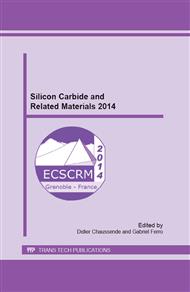p.440
p.444
p.448
p.452
p.456
p.460
p.464
p.468
p.472
Influence of Conduction-Type on Thermal Oxidation Rate in SiC(0001) with Various Doping Densities
Abstract:
It was discovered that the oxidation rate for SiC depended on the conduction type. The oxidation was performed for SiC(0001) with nitrogen doping (n-type) in the range from 2×1016 cm-3 to 1×1019 cm-3, and aluminum doping (p-type) in the range from 2×1015 cm-3 to 1×1019 cm-3, exhibiting a clear dependence. For n-type SiC the oxide thickness increases for higher doping density, and for p-type the thickness decreases. Note that in the case of Si oxidation, there exists very little difference of oxidation rate between the conduction types in such low doping density, and the dependence is peculiar to SiC.
Info:
Periodical:
Pages:
456-459
Citation:
Online since:
June 2015
Authors:
Price:
Сopyright:
© 2015 Trans Tech Publications Ltd. All Rights Reserved
Share:
Citation:


